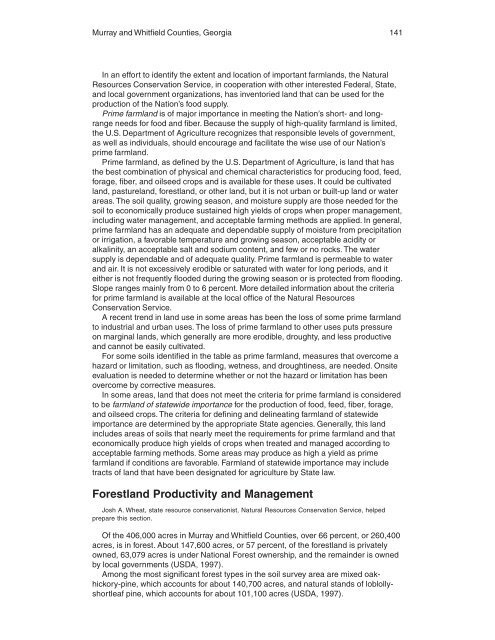Soil Survey of Murray and Whitfield Counties, Georgia
Soil Survey of Murray and Whitfield Counties, Georgia
Soil Survey of Murray and Whitfield Counties, Georgia
You also want an ePaper? Increase the reach of your titles
YUMPU automatically turns print PDFs into web optimized ePapers that Google loves.
<strong>Murray</strong> <strong>and</strong> <strong>Whitfield</strong> <strong>Counties</strong>, <strong>Georgia</strong> 141<br />
In an effort to identify the extent <strong>and</strong> location <strong>of</strong> important farml<strong>and</strong>s, the Natural<br />
Resources Conservation Service, in cooperation with other interested Federal, State,<br />
<strong>and</strong> local government organizations, has inventoried l<strong>and</strong> that can be used for the<br />
production <strong>of</strong> the Nation’s food supply.<br />
Prime farml<strong>and</strong> is <strong>of</strong> major importance in meeting the Nation’s short- <strong>and</strong> longrange<br />
needs for food <strong>and</strong> fiber. Because the supply <strong>of</strong> high-quality farml<strong>and</strong> is limited,<br />
the U.S. Department <strong>of</strong> Agriculture recognizes that responsible levels <strong>of</strong> government,<br />
as well as individuals, should encourage <strong>and</strong> facilitate the wise use <strong>of</strong> our Nation’s<br />
prime farml<strong>and</strong>.<br />
Prime farml<strong>and</strong>, as defined by the U.S. Department <strong>of</strong> Agriculture, is l<strong>and</strong> that has<br />
the best combination <strong>of</strong> physical <strong>and</strong> chemical characteristics for producing food, feed,<br />
forage, fiber, <strong>and</strong> oilseed crops <strong>and</strong> is available for these uses. It could be cultivated<br />
l<strong>and</strong>, pasturel<strong>and</strong>, forestl<strong>and</strong>, or other l<strong>and</strong>, but it is not urban or built-up l<strong>and</strong> or water<br />
areas. The soil quality, growing season, <strong>and</strong> moisture supply are those needed for the<br />
soil to economically produce sustained high yields <strong>of</strong> crops when proper management,<br />
including water management, <strong>and</strong> acceptable farming methods are applied. In general,<br />
prime farml<strong>and</strong> has an adequate <strong>and</strong> dependable supply <strong>of</strong> moisture from precipitation<br />
or irrigation, a favorable temperature <strong>and</strong> growing season, acceptable acidity or<br />
alkalinity, an acceptable salt <strong>and</strong> sodium content, <strong>and</strong> few or no rocks. The water<br />
supply is dependable <strong>and</strong> <strong>of</strong> adequate quality. Prime farml<strong>and</strong> is permeable to water<br />
<strong>and</strong> air. It is not excessively erodible or saturated with water for long periods, <strong>and</strong> it<br />
either is not frequently flooded during the growing season or is protected from flooding.<br />
Slope ranges mainly from 0 to 6 percent. More detailed information about the criteria<br />
for prime farml<strong>and</strong> is available at the local <strong>of</strong>fice <strong>of</strong> the Natural Resources<br />
Conservation Service.<br />
A recent trend in l<strong>and</strong> use in some areas has been the loss <strong>of</strong> some prime farml<strong>and</strong><br />
to industrial <strong>and</strong> urban uses. The loss <strong>of</strong> prime farml<strong>and</strong> to other uses puts pressure<br />
on marginal l<strong>and</strong>s, which generally are more erodible, droughty, <strong>and</strong> less productive<br />
<strong>and</strong> cannot be easily cultivated.<br />
For some soils identified in the table as prime farml<strong>and</strong>, measures that overcome a<br />
hazard or limitation, such as flooding, wetness, <strong>and</strong> droughtiness, are needed. Onsite<br />
evaluation is needed to determine whether or not the hazard or limitation has been<br />
overcome by corrective measures.<br />
In some areas, l<strong>and</strong> that does not meet the criteria for prime farml<strong>and</strong> is considered<br />
to be farml<strong>and</strong> <strong>of</strong> statewide importance for the production <strong>of</strong> food, feed, fiber, forage,<br />
<strong>and</strong> oilseed crops. The criteria for defining <strong>and</strong> delineating farml<strong>and</strong> <strong>of</strong> statewide<br />
importance are determined by the appropriate State agencies. Generally, this l<strong>and</strong><br />
includes areas <strong>of</strong> soils that nearly meet the requirements for prime farml<strong>and</strong> <strong>and</strong> that<br />
economically produce high yields <strong>of</strong> crops when treated <strong>and</strong> managed according to<br />
acceptable farming methods. Some areas may produce as high a yield as prime<br />
farml<strong>and</strong> if conditions are favorable. Farml<strong>and</strong> <strong>of</strong> statewide importance may include<br />
tracts <strong>of</strong> l<strong>and</strong> that have been designated for agriculture by State law.<br />
Forestl<strong>and</strong> Productivity <strong>and</strong> Management<br />
Josh A. Wheat, state resource conservationist, Natural Resources Conservation Service, helped<br />
prepare this section.<br />
Of the 406,000 acres in <strong>Murray</strong> <strong>and</strong> <strong>Whitfield</strong> <strong>Counties</strong>, over 66 percent, or 260,400<br />
acres, is in forest. About 147,600 acres, or 57 percent, <strong>of</strong> the forestl<strong>and</strong> is privately<br />
owned, 63,079 acres is under National Forest ownership, <strong>and</strong> the remainder is owned<br />
by local governments (USDA, 1997).<br />
Among the most significant forest types in the soil survey area are mixed oakhickory-pine,<br />
which accounts for about 140,700 acres, <strong>and</strong> natural st<strong>and</strong>s <strong>of</strong> loblollyshortleaf<br />
pine, which accounts for about 101,100 acres (USDA, 1997).
















